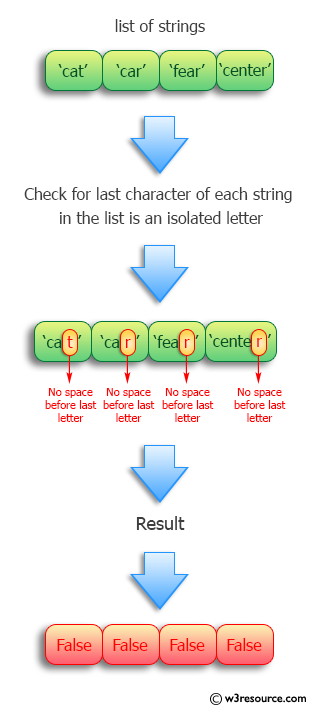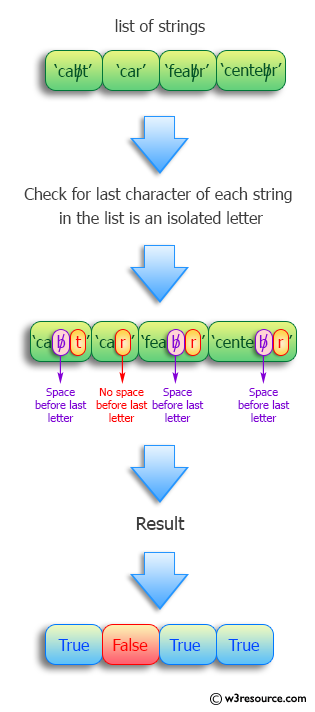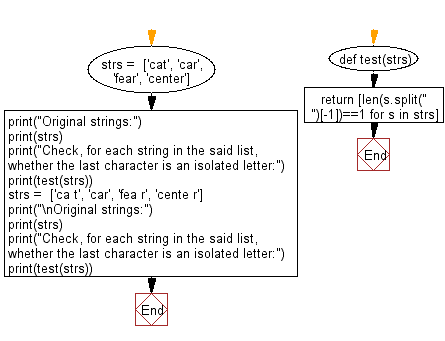Python: Determine, for each string in a list, whether the last character is an isolated letter
Isolated Last Character Check
Write a Python program to check, for each string in a given list, whether the last character is an isolated letter or not. Return True otherwise False.
Input: ['cat', 'car', 'fear', 'center'] Output: [False, False, False, False] Input: ['ca t', 'car', 'fea r', 'cente r'] Output: [True, False, True, True]
Visual Presentation:


Sample Solution:
Python Code:
# License: https://bit.ly/3oLErEI
# Define a function named 'test' that takes a list of strings 'strs' as input
def test(strs):
# List comprehension to check whether the last character of each string is an isolated letter
return [len(s.split(" ")[-1]) == 1 for s in strs]
# Assign a specific list of strings 'strs' to the variable
strs = ['cat', 'car', 'fear', 'center']
# Print the original list of strings 'strs'
print("Original strings:")
print(strs)
# Print a message indicating the operation to be performed
print("Check, for each string in the said list, whether the last character is an isolated letter:")
# Print the result of the test function applied to the 'strs' list
print(test(strs))
# Assign a different list of strings 'strs' to the variable
strs = ['ca t', 'car', 'fea r', 'cente r']
# Print the original list of strings 'strs'
print("\nOriginal strings:")
print(strs)
# Print a message indicating the operation to be performed
print("Check, for each string in the said list, whether the last character is an isolated letter:")
# Print the result of the test function applied to the updated 'strs' list
print(test(strs))
Sample Output:
Original strings: ['cat', 'car', 'fear', 'center'] Check, for each string in the said list, whether the last character is an isolated letter: [False, False, False, False] Original strings: ['ca t', 'car', 'fea r', 'cente r'] Check, for each string in the said list, whether the last character is an isolated letter: [True, False, True, True]
Flowchart:

For more Practice: Solve these Related Problems:
- Write a Python program to check for each string in a list whether its last character is separated by a space from the preceding part.
- Write a Python program to determine if the last character of each string is isolated, meaning it is preceded by whitespace.
- Write a Python program to iterate over a list of strings and return True for those whose last character is not connected to the rest of the word.
- Write a Python program to split each string and verify if the final element is a standalone character.
Go to:
Previous: Determine the direction ('increasing' or 'decreasing') of monotonic sequence numbers.
Next: Compute the sum of the ASCII values of the upper-case characters in a given string.
Python Code Editor :
Have another way to solve this solution? Contribute your code (and comments) through Disqus.
What is the difficulty level of this exercise?
Test your Programming skills with w3resource's quiz.
